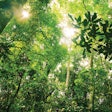During my visit to Malaysia last month, I went to a government forestry station and talked with rangers and forestry officers about their work ensuring that all logging is both legal and sustainable. The officials outlined in great detail the work that is done before, during and after harvest. Many of the steps are now common sense in good forestry programs around the world: advance forest inventories, highly selective logging based on both diameter and tree species retention, the protection of both "mother trees" and high value conservation species, proper boundary lines and the pre-planning of roads, log yards and falling direction to minimize incidental damage to the surrounding forest. All harvest sites are actively monitored and plans are adapted if needed during the process under the principle of "if in doubt, don't cut."
In addition to the above, they have an aggressive rehabilitation program of the skid trails and log yards with high value species seedlings. I've been in a number of commercial forests with excellent low impact trails, but most operations allow them to naturally regenerate rather than directly replant. Both are viable alternatives, but it was interesting to note that Malaysia is intent on increasing the value of their forest resource.
Another point I appreciated was their requirement to use plastic culverts rather than hollow logs and their exclusion of log-bridges. This is an improvement over what I've seen in Africa, for example. It was pointed out that hollow logs quickly become clogged or release some of their own biomass into the water causing downstream pollution. The log bridges frequently break down, again polluting the streams and causing transport delays. They are often safety hazards as they are not always as structurally sound as you might want and they usually have packed earth roads which quickly become muddy. The government requires all the bridgework and drainage systems to be removed after harvest, so there is no extra rotting biomass filling the watershed. Finally, while most drainage logs are traditionally hollow logs with no commercial value, most log bridges need to be made of solid trunks of heavy density wood-why waste the good trunks when you can use them for timber and reuse your portable bridges the next year at another site?
Rangers outlined how they define forests as permanently protected or active for commercial harvest or for mixed-use programs. They talked in depth about the many systems they have in place to prevent illegally logging-including a program with FRIM where they are working on DNA studies in major forests. It was a very interesting morning and we took a couple of small hikes through some of the surrounding woods to compare regenerated forest regions with old growth areas. It was nearly impossible to tell the difference.
Now in addition to their national standards for logging, Malaysia is aggressively developing their own national certification program. The program has been endorsed by the European certification system known as PEFC (Programme for the Endorsement of Forest Certification). They have multiple FMUs (Forest Management Units) across the country that have been certified and over a hundred companies who have received chain of custody certification. Nearly 5 million hectares of forestland is in the program.
However, what impresses me most about the system is that they also have some suspended certifications. The Malaysian Timber Certification Scheme (MTCS) is not just saying, "Everything in Malaysia is OK." They are taking the strong national standards and then going beyond them, requiring an even higher performance level. And then, more importantly, they're enforcing those standards and monitoring their participants. They are continuing to refine the program, adapting and expanding the standards and working with international organizations to create a strong healthy certification system for a strong, healthy and valued timber resource.
For more information on the Malaysian industry, visit www.mtcc.com.my/.
































